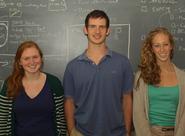
The ability to pick up an object without knocking it over is something that most people take for granted, but Emma Geduldig ’13, Sarah Andrews ’14 and John Wildman ’15 are more inquisitive when it comes to movement and motor control. Why, they ask, do we move to pick up a coffee cup from the side as opposed to the front? Such simple questions on human motion have yet to be entirely answered, and these researchers hope to shed more light on this seldom- researched subject.
Motor control is classically explained by Fitts’s Law, which states that the time it takes to touch a set of targets is a function of the size of those targets and the distance between them, but these students are challenging Fitts’s established notion. They’re furthering James L. Ferguson Professor of Psychology John Vaughan’s previous research, which suggests that target size and distance have a more complex relationship.
According to Wildman, the students are “one of the only groups examining these particular intricacies of motor control and action planning. We can look at studies done in the early 1900s, and apply methods of research that give [the students] a fresh look.”
Geduldig, Andrews and Wildman are also examining the effects of hand dominance, differences in the kinematics (mechanical motion) of the left and right arms’ movements as they try to achieve the same goal, and differences in kinematics which emerge when an obstacle is placed between targets. This research has the potential to provide a greater understanding and more accurate models of human movement. The students hope that their study will lead to a better understanding of how paralysis and motor movement- related diseases such as Parkinson’s affect the human body.
In order to determine how the aforementioned factors affect motor control, the three students are collecting and interpreting data using a system called Nest of Birds and the Matlab for Psychologists software suite. Participants are fitted with the Nest of Birds sensors and asked to complete tasks that study arm and hand movement in relation to target objects. Despite Professor Vaughan’s previous research on this issue, the group still had to complete significant preparatory work before they could even begin their trials. The researchers had to learn the both the functionality and programming language of the Matlab suite and then modify the Matlab program itself so that it record information concerning the velocity, accuracy and kinematics of the participants’ motion.
Once the data from the Nest of Birds sensor array is collected and interpreted by Matlab, the research group will go on to analyze it in the context of Fitts’s Law and the findings of previous studies. The group has yet to decide how to analyze the data, but Geduldig remarked that the early results give indication that the data will be “more statistically significant than [the results] of previously published studies.” Based on their previous research and their preliminary results, the group suspects that target size may be having an effect on of the kinematics of arm and hand movement.
Professor Vaughan’s researchers are a diverse group both in their academics and in their extracurricular interests. Andrews in pursuing a double concentration in psychology and math with a minor in philosophy, Geduldig is a neuroscience concentrator and Wildman is a prospective neuroscience concentrator. Outside of the lab, Andrews is an Outreach Adventure Leader, a Community Outreach and Opportunity Project ABC tutor and a member of the Hamilton College orchestra. Geduldig is an avid dancer, and it was the idea of motion in dance that first interested her in Professor Vaughan’s research. Wildman is a volunteer firefighter in Clinton and will be a resident advisor in the coming year.
Emma Geduldig is a graduate of Hershey High School (Pa.), Sarah Andrews is a graduate of Joel Barlow High School (Conn.) and John Wildman is a graduate of Cincinnati Country Day School (Ohio).
Posted June 20, 2012
